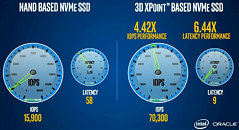- Joined
- Oct 9, 2007
- Messages
- 47,293 (7.53/day)
- Location
- Hyderabad, India
| System Name | RBMK-1000 |
|---|---|
| Processor | AMD Ryzen 7 5700G |
| Motherboard | ASUS ROG Strix B450-E Gaming |
| Cooling | DeepCool Gammax L240 V2 |
| Memory | 2x 8GB G.Skill Sniper X |
| Video Card(s) | Palit GeForce RTX 2080 SUPER GameRock |
| Storage | Western Digital Black NVMe 512GB |
| Display(s) | BenQ 1440p 60 Hz 27-inch |
| Case | Corsair Carbide 100R |
| Audio Device(s) | ASUS SupremeFX S1220A |
| Power Supply | Cooler Master MWE Gold 650W |
| Mouse | ASUS ROG Strix Impact |
| Keyboard | Gamdias Hermes E2 |
| Software | Windows 11 Pro |
At the Oracle OpenWorld conference, Intel took the opportunity to show off its latest implementation of the revolutionary 3D XPoint memory technology, which aims to replace NAND flash as the staple high-performance solid-state storage technology; offering exponential gains in density and performance. Optane, codename for Intel's upcoming 3D XPoint SSD based on conventional storage interfaces (PCIe M.2, U.2, PCIe add-on card) and the modern NVMe protocol; was demoed on Oracle's X5-2 series 1U server, where it clocked 4.42 times the random access performance, and 6.44 times better latency, than the fastest NAND flash based SSD in those form-factors. Optane promises 7.13 times the throughput when used with Oracle software.
That was only part of the presentation. The other being an audacious new contraption, a prototype 3D XPoint based SSD in the DDR4 DIMM form-factor. Intel envisions high-capacity SSD storage to eliminate most system-level bottlenecks, and talk directly to the processor's integrated memory controller. System builders will be able to combine DDR4-DRAM memory modules with Optane DIMM modules over vacant channels, and end up with the lowest possible latency storage interface. According to Intel CEO Brian Krzanich, Optane DIMM modules will be the closest that storage will have ever gone to the performance levels of DRAM, and should greatly accelerate in-memory database implementations.



View at TechPowerUp Main Site
That was only part of the presentation. The other being an audacious new contraption, a prototype 3D XPoint based SSD in the DDR4 DIMM form-factor. Intel envisions high-capacity SSD storage to eliminate most system-level bottlenecks, and talk directly to the processor's integrated memory controller. System builders will be able to combine DDR4-DRAM memory modules with Optane DIMM modules over vacant channels, and end up with the lowest possible latency storage interface. According to Intel CEO Brian Krzanich, Optane DIMM modules will be the closest that storage will have ever gone to the performance levels of DRAM, and should greatly accelerate in-memory database implementations.



View at TechPowerUp Main Site





